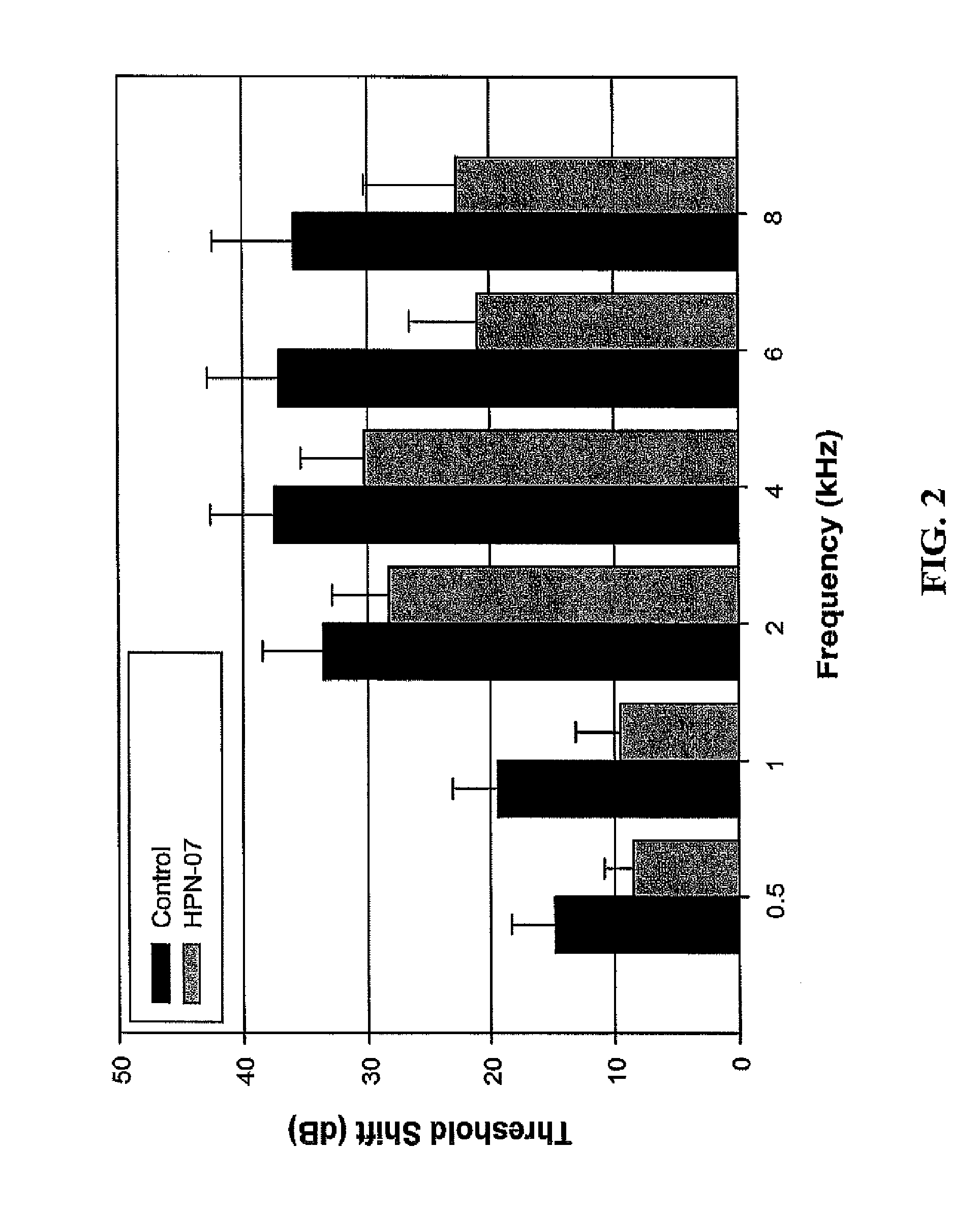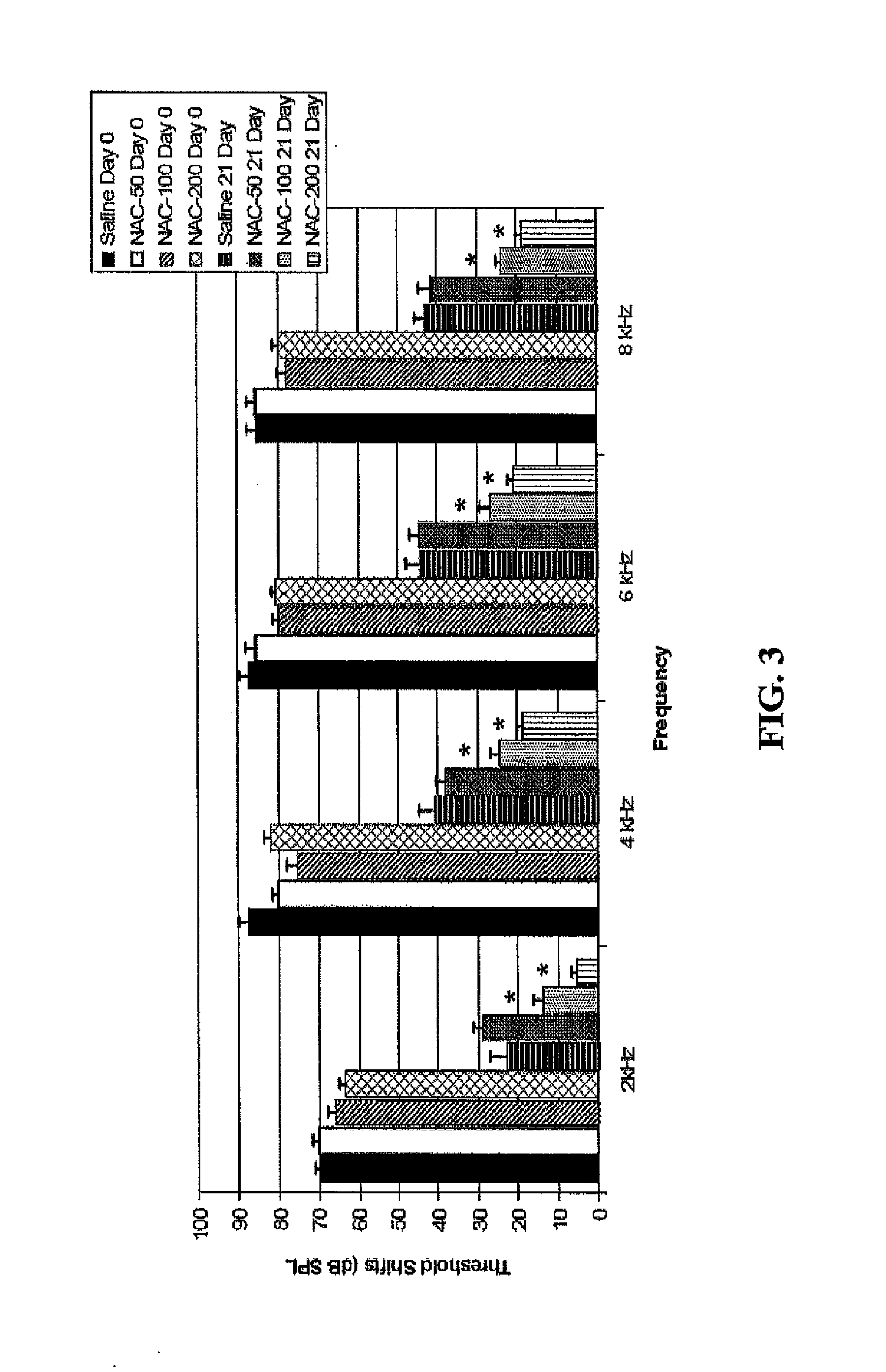Methods for treating acute acoustic trauma
a technology of acute acoustic trauma and treatment methods, applied in the direction of antinoxious agents, drug compositions, peptide/protein ingredients, etc., can solve problems such as permanent hearing loss
- Summary
- Abstract
- Description
- Claims
- Application Information
AI Technical Summary
Benefits of technology
Problems solved by technology
Method used
Image
Examples
example 1
[0039]The purpose of this example is to demonstrate that 2,4-disulfonyl PBN (HPN-07) is effective to treat hearing loss induced by AAT.
[0040]All data values in FIGS. 1 and 2 are represented as means±SEM. Statistically significant differences in threshold shifts were tested via ANOVA (SPSS 14.0 for Windows). Frequency was treated as within subject factor while treatment was the between-subjects factor. When a main effect was found, post-hoc tests such as LSD and Tukey was performed for mean comparisons among different groups. A p-value less than 0.05 represents a statistically significant difference.
[0041]FIG. 1 represents the average threshold shift across all frequencies tested at 21 days post AAT. As demonstrated therein, adult chinchillas receiving HPN-07 (n=5) had a significantly decreased average threshold shift compared to control animals not receiving the compound (n=6). As demonstrated in FIG. 2, the most pronounced effect of HPN-07 occurred at 0.5, 1, 6 and 8 kHz, while the...
example 2
[0042]The purpose of this example is to demonstrate the effectiveness of NAC in treating hearing loss in an animal model.
[0043]Six chinchillas per experimental group were administered either saline (control), 50,100, or 200 mg / kg of NAC via intraperitoneal (i.p.) injection at 4 hours post AAT exposure. Statistical analysis was performed using a two way ANOVA and Post hoc test, “*” denotes a p<0.05.
[0044]As depicted in FIG. 3, NAC demonstrates a mild effect on threshold shift soon after treatment. However, at 21 days following AAT exposure, there is a significant decrease in threshold shift in animals receiving 100 mg / kg and 200 mg / kg of NAC. These results demonstrate that antioxidants, such as NAC, are effective in treating hearing loss associated with AAT.
example 3
[0045]The purpose of this example is to demonstrate the effectiveness of 2,4-disulfonyl PBN in combination with NAC for treating hearing loss in an animal model.
[0046]FIGS. 4A and 4B illustrate the synergistic effect of a combination treatment comprising NAC and 2,4-disulfonyl PBN. In this example, chinchillas were orally administered either control (10% sucrose) (n=6), HPN-07 (n=5) or HPN-07+NAC (n=3). Threshold was measured 21 days post AAT. Data in FIG. 4A represents the average threshold shift for each individual frequency tested. The data in FIG. 4B represents the combined average threshold shift data from 2 kHz to 8 kHz. Data were analyzed via a two-way ANOVA, Bonferroni test “**” denotes a p value of less than 0.01 and “***” denotes a p value of less than 0.001.
[0047]Threshold shifts were found in the control group and treated groups at all frequencies with greater shifts in the high frequencies (2-8 kHz). See FIG. 4A. As demonstrated in FIG. 4A, treatment with HPN-07 alone r...
PUM
| Property | Measurement | Unit |
|---|---|---|
| Mass | aaaaa | aaaaa |
| Mass | aaaaa | aaaaa |
| Mass | aaaaa | aaaaa |
Abstract
Description
Claims
Application Information
 Login to View More
Login to View More - R&D
- Intellectual Property
- Life Sciences
- Materials
- Tech Scout
- Unparalleled Data Quality
- Higher Quality Content
- 60% Fewer Hallucinations
Browse by: Latest US Patents, China's latest patents, Technical Efficacy Thesaurus, Application Domain, Technology Topic, Popular Technical Reports.
© 2025 PatSnap. All rights reserved.Legal|Privacy policy|Modern Slavery Act Transparency Statement|Sitemap|About US| Contact US: help@patsnap.com



